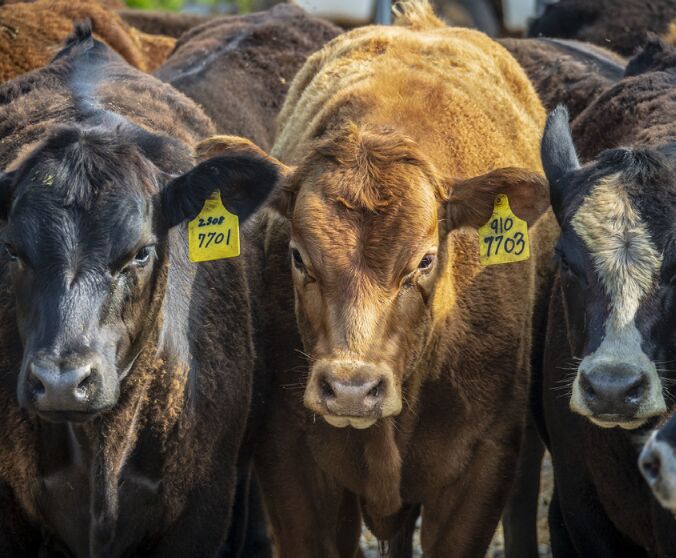FSA programs can help livestock producers affected by drought, wildfires

Zach Ducheneaux, administrator of the Farm Service Agency, said two FSA programs have a Jan. 30 deadline for filing applications.
The Emergency Assistance for Livestock, Honeybees, and Farm-raised Fish Program, or ELAP, and the Livestock Forage Disaster Program, or LFP, close soon, and Ducheneaux said not to wait until the deadline to get applications in.
“Don’t wait until the 30th,” he said. “Let’s get them in, because the sooner we get them in, the sooner we can get started making the payments.”
According to FSA, ELAP provides financial assistance to eligible producers of livestock, honeybees and farm-raised fish for losses due to disease, certain adverse weather events or loss conditions, including blizzards and wildfires, as determined by the Secretary of Agriculture. ELAP assistance is provided for losses not covered by other disaster assistance programs authorized by the 2014 farm bill and the Bipartisan Budget Act of 2018, such as losses not covered by LFP and the Livestock Indemnity Program.
“ELAP is really for a wide swath of producers—everything from farm raised fish, sport fish and fish food fish to cow-calf operators to feeders and stockers,” he said. “So I think it’s a pretty broad ranging program. It’s really one of our catch all programs for all of the things that don’t fit in the other standing disaster programs.”
The signup, for both ELAP and LFP, is for conditions experienced during the 2021 calendar year, Ducheneaux said.
Producers needing extra help for their grazing livestock, including cattle, buffalo, horses, llamas, sheep and goats, can apply for LFP.
“You name it, if they’re grazing it, and they’ve got the acres of grazing land to support it that are in native or permanently established vegetative cover they can qualify for livestock forage program,” he said. “That program will pay up to five months and 60% of the cost to replace a lost forage.”
Ducheneaux said both ELAP and LFP are triggered by the U.S. Drought Monitor and LFP has a map on the FSA site showing eligible counties. LFP funds can be used to buy feed and replace that income that had been used to buy feed already.
“We understand the nature of our disaster programs is that a lot of the things that we help with funding for come after the fact,” he said. “There’s going to be replacement of other operating capital but it’s a start.”
Ducheneaux said producers all across the country have indicated to them that none of them could have imagined a drought of this scale and duration.
“The five months worth of forage replacement doesn’t really go very far,” he said. “I think that’s what Congress had on their mind when they asked the disaster assistance in their continuing resolution.”
The local FSA office can tell producers the specifics of both ELAP and LFP. For LFP, the county committees, are the ones who determine the approval or not and FSA officials can determine what documentation is needed. ELAP is a broader ranging program and requires receipts for expenses incurred.
“One of the changes we made in ELAP this year was to allow for assistance to producers to help with increased forage hauling costs,” he said. “If you’re having to buy your hay from further away, (this) will help with that difference.”
There’s also some changes for the water hauling aspect of ELAP, which can help in an emergency type situation like a wildfire would present.
“So a producer can start to access that sooner rather than later in a disaster,” he said. “Previously, you had to be in a little longer standing disaster to use that water hauling. We made that more readily accessible.”
For more information about ELAP visit www.fsa.usda.gov/Assets/USDA-FSA-Public/usdafiles/FactSheets/elap-general-fact-sheet.pdf. For more information about LFP visit www.fsa.usda.gov/Assets/USDA-FSA-Public/usdafiles/FactSheets/livestock_forage_program_lfp-fact_sheet.pdf.
Another program that could help those producers affected by the drought and wildfires is the Livestock Indemnity Program. Its deadline is March 1.
“That might be especially relevant for some of your ranchers out there that may have lost some livestock in that fire,” he said. “And that will provide up to 75% of the market value of the livestock that were lost.”
Producers will need production records, possibly third party verification from veterinarians or other documentation to show loss.
“Anything they can to document those numbers is helpful for those county committees and approved getting them approved expeditiously,” Ducheneuax said.
One final program Ducheneaux discussed was the Emergency Conservation Program or ECP.
“It can provide emergency conservation measures or funding for emergency conservation measures in time of drought,” he said. “One of the changes we made in that program is adding the capacity for a producer to install a solar pump where they have water and move it to another section of the pasture where they may be have grazing, but no water.”
ECP is administered locally by the county and state offices and they have to establish a deadline when they request that disaster assistance.
“Many times this year, especially with this long standing drought, the drought impacts are going beyond the deadline,” he said. “And producers are realizing drought impacts after the deadline.”
Applications are at the local FSA office, and if past the deadline, the local offices can let the national office know they’ve gotten applications for drought assistance.
“And we can get them the tools they need to approve that for eligible producers after that established deadline,” he said.
The ongoing drought is something FSA will continue to evaluate and adjust programs accordingly.
“The disaster clock sort of resets after the first of the year,” Ducheneaux said. “Congress recognized that this is a longer standing event than what we’re normally accustomed to so they appropriated some money in the fall of 2021 for us to deliver in 2022 began to help mitigate these long standing impacts.”
Kylene Scott can be reached at 620-227-1804 or [email protected].


